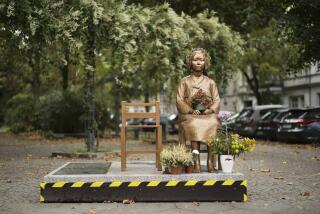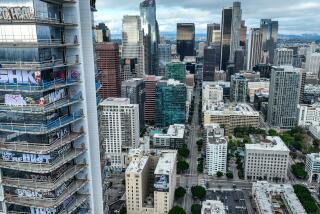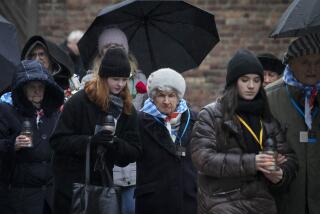Postscript : A Symbol of Infamy Is Put Out to Pasture : Much of the Berlin Wall now lies in sections in a field near the city it once divided. The material will be reused to help rebuild the nation.
- Share via
PHILIPPSTHAL, Germany — Strewn across an open field as far as the eye can see near this little farming community lie pieces of the old Berlin Wall, as broken and useless as the idea the infamous structure vainly tried to protect.
Here, 15 miles southwest of the city it once divided, sections of the wall--along with parts of old watchtowers, concrete fence posts and assorted other debris--are being broken up and ground into small pieces that will be used as raw material for building new roads--roads that will help re-establish the links between the reunited German states.
Amid the growing realization of how difficult the unification process has become, the destruction of the most powerful symbol of Germany’s long division has moved so fast that tourists visiting Berlin now have to hunt for sections of the barrier still standing.
Parliamentary State Secretary Ottfried Hennig in Bonn’s Defense Ministry told his fellow legislators late last month that nearly 90% of the wall had already been removed, and Defense Ministry officials said that the balance will be gone by the end of the year.
Roads severed by the wall’s construction 29 years ago are gradually being reconnected. The 50-yard wide death strip, just east of the old wall that was once heavily mined, is now a harmless swath of dirt and grass, configured variously along its 100-mile length as a parking lot, a children’s playground, a picnic spot and Europe’s most extensive inner-city bicycle path.
Long-term development of the death strip has become an issue bitterly contested between environmentalists, who see a unique opportunity to preserve the open land as a park, and ambitious planners, who talk of erecting new apartment buildings to ease the city’s housing crisis or extending Berlin’s heavily traveled urban freeway.
There’s also a fringe debate on whether to preserve or destroy the remains of Adolf Hitler’s bunker, which lies under the death strip, near the city center.
In a highly controversial deal made last year, the city sold one piece of prime death-strip land at Potsdamer Platz, in the heart of pre-World War II Berlin, to car maker Daimler-Benz, which plans to build a high-rise office building there.
A study containing formal proposals for the rest of the death strip’s development is scheduled to be presented later this month to Berlin’s governing Mayor Eberhard Diepgen and the mayors of the city’s 15 districts.
With the prospect that Berlin will once again become the seat of the German government, swift action is required, said Patricia Werner, spokeswoman for the Berlin city government’s Department of Development and Environmental Protection. “It would be wonderful to be able to take as much time as we wish, but there is a lot of pressure,” she said. “We want to decide well, but we also need to decide quickly.”
Meanwhile, the speed with which the barrier has disappeared concerns some city officials and local historians anxious to preserve at least token portions of the wall, both as a memorial to those who died trying to cross it and as a reminder of the city’s long, painful division.
“It’s impossible to understand if you can’t see it,” argued Christoph Stoelzl, director of the German National Museum in western Berlin, in a recent newspaper article.
The sentiment is also shared in the eastern, former Communist-controlled part of the city.
“Berlin must be allowed to grow together, but there must be reminders of what was there,” said Laurenz Demps, a specialist on the city’s history at Humboldt University. “To remove it all would be to leave us with no feeling of our own past.”
As do other historians, Demps argued that any reminder must be in the central part of the city, not on its outskirts. “People have to look at it,” he said. “It has to hurt.”
Not all agree, however.
“Are you crazy?” screamed one indignant resident just northwest of the city center when a local German reporter told him of a plan to preserve a section of the wall in his neighborhood as a memorial. “I’ve lived 29 years with that thing in front my nose, and now you’re saying its should stay there?”
The neighborhood, along the Bernauer Strasse, is where families jumped from upper story windows to freedom on the August, 1961, morning the wall was erected. A year later, 18 year-old Peter Fechter was shot by East German sentries as he tried to cross the wall near the same spot. The youth, moaning as he lay helpless at the base of the wall, was left for hours as he bled to death in what became one of the most notorious incidents along Berlin’s divide.
The location is thus considered particularly appropriate for a memorial, and a 200-yard-long stretch of the wall has been preserved there at least temporarily. There’s a fence around it to keep souvenir hunters away, but city officials insist nothing has been definitively decided.
“We’d like to see it (the memorial) go there, but we’re aware of the local resistance,” said Werner. “There will be more discussions with residents.”
As with so much of eastern German land that was confiscated by the Communists, parts of the death strip adjacent to Bernauer Strasse have been reclaimed by the previous owners--in this instance, three churches that are said to have little interest, either in the wall memorial or the urban expressway extension city transportation experts would like to see there.
Another, nearly mile-long stretch of wall south of the Alexander-platz may also be spared because its surface became an extended canvas for alternative arts in the months after the November, 1989, revolution.
Now known as the “East Side Gallery” and advertised as the world’s largest outdoor art exhibit, it has become a part of city bus tours.
While hustling petty entrepreneurs have made tidy profits by selling small chunks of the wall to tourists, German Defense Ministry efforts to sell off large slabs of the barrier have so far been less successful.
A typical section, 4 feet wide and 11 feet high, sells for only $50, but transportation is the major inhibitor. Such a piece weighs nearly 3 tons.
“We’re still selling some pieces, but it’s not much of a business,” said Defense Ministry spokesman Stefan Lang.
More to Read
Sign up for Essential California
The most important California stories and recommendations in your inbox every morning.
You may occasionally receive promotional content from the Los Angeles Times.










